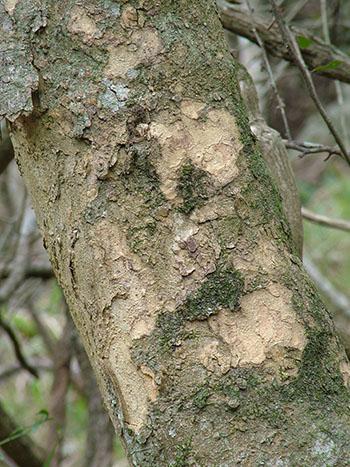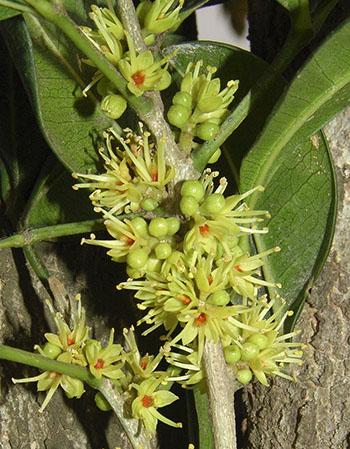Teclea gerrardii
Teclea gerrardii I.Verd.
Family: Rutaceae
Common names: Zulu cherry-orange, flaky-barked cherry-orange (Eng.); Zulukersielemoen (Afr.); umozane (isiZulu); umboza, inzinyana, (isiXhosa)
SA Tree No: 263
Introduction
The Zulu cherry-orange is an ornamental tree that grows well in sunny or shady positions and invites wildlife to gardens because of its attractive, fleshy, reddish-orange fruits.

Description
Description
Teclea gerrardii is a small to medium tree, to 5 m tall, with a crown that spreads in the open. Its stem is smooth with mottled grey bark and often with circular patches, flaking to expose yellowish underbark; and the branchlets have lenticels.

The leaves of Teclea gerrardii are 3-foliate, with narrowly winged and grooved stalks of about 10–25 mm long. The leaflets with rounded or notched tips are broad in the middle or towards apex and the side leaflets are dull green, paler below and stalkless with margins that are rolled under conspicuous veins. The crushed leaves have a strong, rather pungent smell.
The flowers are yellowish to green and are in short, unbranched, axillary inflorescences. It flowers in spring and early summer, from August to January. The fruits are small, fleshy, velvety green and hairy at first, but when ripen becomes reddish orange and hairless and covered in small raised lumps. The fruits are arranged on very short stalks in axillary groups of 1 to 3.

Conservation Status
Status
Teclea gerrardii was not screened as potential taxa of conservation concern, and was given an automatic status of Least Concern (LC). It is not considered to be under any immediate risk of extinction.
Distribution and habitat
Distribution description
Teclea gerrardii is found in coastal dune bush, forest and riverine vegetation at low altitudes in Eastern Cape, KwaZulu-Natal and Mpumalanga. It is also distributed in southern Mozambique and Swaziland.
Derivation of name and historical aspects
History
The genus Teclea was named after Tekle or Takla Haimanout, ancient Ethiopian emperor. The genus was published in 1843 by the French botanist, Alire Raffeneau Delile. This species is named after William Tyrer Gerrard (c.1831–1866), an Englishman and collector of plants, insects and birds, who was active in Australia, KwaZulu-Natal and Madagascar.
Teclea is a genus of ± 22 species that occur in Africa and Mascarene Islands with four in southern Africa, occuring in Mpumalanga, Swaziland and the eastern coastal region. Teclea gerrardii looks very similar to Teclea trichocarpa that occurs in southeastern Zimbabwe and adjacent Mozambique, but has deeply velvety ripe fruits. Teclea gerrardii falls under the citrus and buchu family, Rutaceae.
Ecology
Ecology
The flowers of Teclea gerrardii attract beetles, and the fruits are eaten by monkeys and birds.
Uses
Use
Crushed bark decoctions of Teclea gerrardii are taken for chest irritations associated with coughs and colds.

Growing Teclea gerrardii
Grow
Teclea gerrardii is grown from the seeds. When its fruits are ripe, one needs to remove the fleshy layer, or alternatively that is done by birds and other wildlife. Leave the seeds to dry out before growing them. Be cautious not to dry the fruits in direct sun, as it will destroy other cells of the plants and that will prevent the seeds from germinating. You can germinate the seeds in sterile river sand and grow it in a soil mixture of river sand, loam and clay soils.
Teclea gerrardii can make a great container plant and it is suitable for growing in a small garden.
References
- Boon, R. 2010. Pooley's trees of eastern South Africa, a complete guide. Flora & Fauna Publications Trust, Durban.
- Glen, H. 2004. Sappi what’s in a name?. Jacana Media (PTY) Ltd. Johannesburg. 13, 53, 68.
- Foden, W. & Potter, L. 2005. Teclea gerrardii I.Verd. National Assessment: Red List of South African Plants version 2015.1. Accessed on 2016/05/10
- Hutchings, A., Scott, A.H., Lewis, G. & Cunningham, A.B. 1996. Zulu medicinal plants: an inventory. University of Natal Press, Pietermaritzburg.
- Leistner, O.A. (ed.). 2000. Seed plants of southern Africa: families and genera. Strelitzia 10. National Botanical Institute, Pretoria.
- Pooley, E. 2003. The complete field guide to trees of Natal, Zululand and Transkei, Edn 1. Natal Flora Publication trust.
- Van Wyk, B. & Van Wyk, P. 1997. Field guide to trees of southern Africa. Struik, Cape Town.
- Wikipedia: https://en.wikipedia.org/wiki/William_Tyrer_Gerrard accessed 10 May 2016
Credits
Aluwani Tshiila
KwaZulu-Natal Herbarium, Durban
May 2016
Plant Attributes:
Plant Type: Tree
SA Distribution: Eastern Cape, KwaZulu-Natal, Mpumalanga
Soil type: Sandy, Clay, Loam
Flowering season: Spring, Early Summer
PH: Neutral
Flower colour: Yellow
Aspect: Full Sun
Gardening skill: Easy
Special Features:
Horticultural zones








Rate this article
Article well written and informative
Rate this plant
Is this an interesting plant?
Login to add your Comment
Back to topNot registered yet? Click here to register.